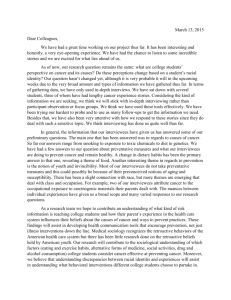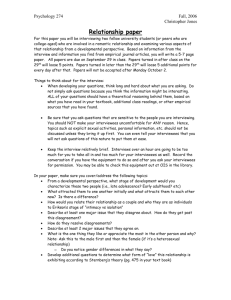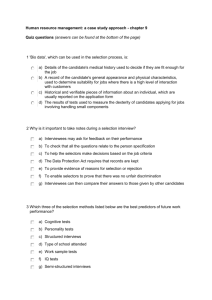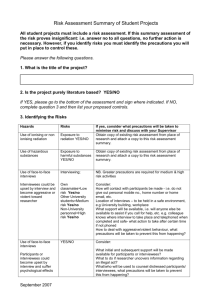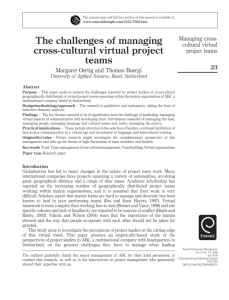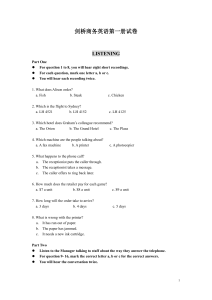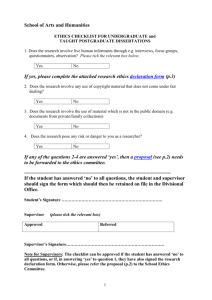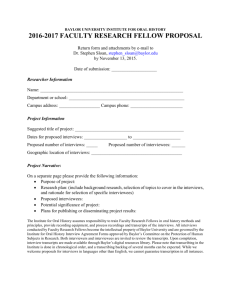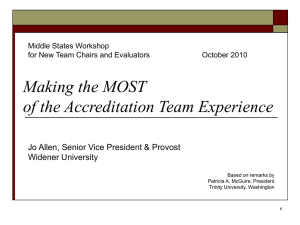The problem of communication in construction
advertisement
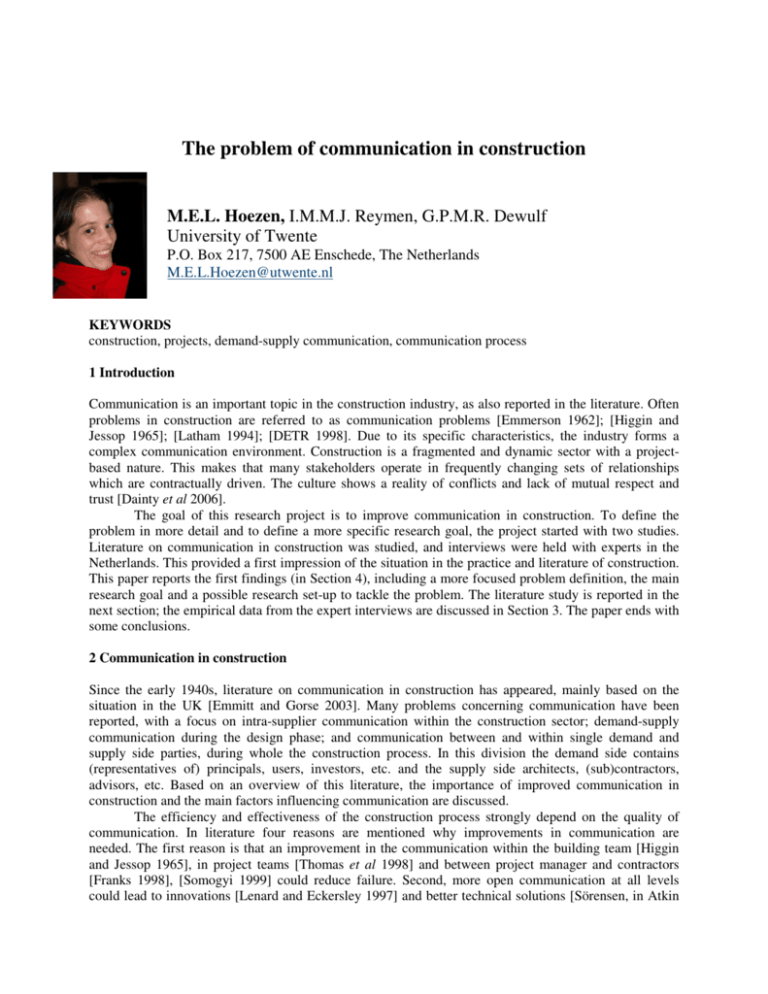
The problem of communication in construction M.E.L. Hoezen, I.M.M.J. Reymen, G.P.M.R. Dewulf University of Twente P.O. Box 217, 7500 AE Enschede, The Netherlands M.E.L.Hoezen@utwente.nl KEYWORDS construction, projects, demand-supply communication, communication process 1 Introduction Communication is an important topic in the construction industry, as also reported in the literature. Often problems in construction are referred to as communication problems [Emmerson 1962]; [Higgin and Jessop 1965]; [Latham 1994]; [DETR 1998]. Due to its specific characteristics, the industry forms a complex communication environment. Construction is a fragmented and dynamic sector with a projectbased nature. This makes that many stakeholders operate in frequently changing sets of relationships which are contractually driven. The culture shows a reality of conflicts and lack of mutual respect and trust [Dainty et al 2006]. The goal of this research project is to improve communication in construction. To define the problem in more detail and to define a more specific research goal, the project started with two studies. Literature on communication in construction was studied, and interviews were held with experts in the Netherlands. This provided a first impression of the situation in the practice and literature of construction. This paper reports the first findings (in Section 4), including a more focused problem definition, the main research goal and a possible research set-up to tackle the problem. The literature study is reported in the next section; the empirical data from the expert interviews are discussed in Section 3. The paper ends with some conclusions. 2 Communication in construction Since the early 1940s, literature on communication in construction has appeared, mainly based on the situation in the UK [Emmitt and Gorse 2003]. Many problems concerning communication have been reported, with a focus on intra-supplier communication within the construction sector; demand-supply communication during the design phase; and communication between and within single demand and supply side parties, during whole the construction process. In this division the demand side contains (representatives of) principals, users, investors, etc. and the supply side architects, (sub)contractors, advisors, etc. Based on an overview of this literature, the importance of improved communication in construction and the main factors influencing communication are discussed. The efficiency and effectiveness of the construction process strongly depend on the quality of communication. In literature four reasons are mentioned why improvements in communication are needed. The first reason is that an improvement in the communication within the building team [Higgin and Jessop 1965], in project teams [Thomas et al 1998] and between project manager and contractors [Franks 1998], [Somogyi 1999] could reduce failure. Second, more open communication at all levels could lead to innovations [Lenard and Eckersley 1997] and better technical solutions [Sörensen, in Atkin et al 2003]. Third, communication improvements in early phases of projects would positively influence the quality as perceived by all stakeholders involved [Emmit and Gorse 2003]; [Brown 2001]; [Usmani and Winch 1993]. Finally, improved communication during the briefing might lead to better decisionmaking, for example less haste in moving to solutions and better ways of looking at the requirements first [Nutt 1988]; [Barrett 1995]; [Salisbury 1998]. Communication is influenced by several factors; an overview can be derived from literature. The first type of factors is related to the organization of the construction process. Main aspects are the difference between formal and informal communication routes during the design phase [Mackinder and Marvin 1982] as well as during the phases of development [Pietroforte 1992], [Higgin and Jessop 1965]; and the divorce of design and production [Hill 1995]; [Emmerson 1962]. The second type of factors is related to the stakeholders themselves. Opposing interests could lead to hidden agenda’s, often leading to restricted communication [Richardson 1996]; [Brown 2001]; [Cuff 1996]; [Preiser 1993]; [CIB 1997]; [DETR 1998], and all stakeholders’ (assumed) frames of reference are found of great influence on communication as well [Moore and Dainty 2001]; [Salisbury and White 1980]; [Gray et al 1994]; [O’Reilly 1996]; [Usmani and Winch 1993]. Over the years, several studies concluded thus that the construction sector could benefit from improved communication. Although the studies highlight several aspects of communication in construction, no literature overview has been found on demand-supply communication in construction. Studies focus on intra-supplier communication (between head- and subcontractors for example) or intrademander communication (between principal and end user for example), or study just one phase of the building process. In the cases where communication between demand side parties and supply side parties was studied, the focus was on just a few stakeholders instead of taking into account many parties of each side. 3 Practice of communication in construction The structure of the Dutch construction industry does not differ so much from the UK, except for the fact that Dutch industry is highly regulated in comparison with the UK [Bosch and Philips 2003], and that the UK subcontracting system (as opposed to the Dutch) allows for principals to contract directly to subcontractors [Atkins 1994]. Communication problems seem to be similar as well, as for example shown by the attention paid to this topic by PSIBouw – the Dutch network of innovators in construction – in their program ‘Rethinking Construction’. Open interviews with all kinds of stakeholders within the Dutch construction industry have provided more insights. Their ideas on communication problems in construction in the Netherlands are reflected in this section. The section starts with describing the research method used to perform the empirical study. 3.1Research methodology To obtain more insight in communication problems, seven experts on the practice of communication in construction were interviewed. The interviewees were selected based on their profession (constructor, consultant or professional principal); the type of projects they were procuring or working at (Infrastructure, public utility building or housing); and the domain they were working in or building for (public or private). The data were collected in semi-structured, in-depth interviews. The format was that of a conversation with a structure and a purpose. To further ensure the richness of the method, the interviewees were first informed about the aim of the study, the financer, what their participation involved, and how the results would be disseminated. Then they were asked to think of one or more specific projects that they were currently working on or had recently completed. Open interview questions based on the purpose of the study allowed interviewees to talk about their experience. During the interviews notes were made, which were transcribed directly after each interview. Remarks of all kinds were put into one of the three categories characteristics of the Dutch construction industry; the importance of communication; and factors influencing communication. The interview method chosen caused that not all of the interviewees’ remarks were comparable. For example: some interviewees focused on the organization of the construction industry as a whole, while others went into detail about contractual aspects. Despite these differences (mainly in scale), there were lots of parallels and opposed views, drawing a clear picture of the communication environment as formed by the construction industry. After the analysis, an overview of main topics was presented to the group of interviewees, sitting together. A discussion took place, during which nuances, additions and clarifications were made. Interviewees explained their views to each other, providing more insight in the background of opposing ideas. Based on this meeting, conclusions were drawn. 3.2 Results Characteristics of the Dutch construction industry The picture of the Dutch construction industry, as painted by the interviewees, is one of an industry made up of conservative, poor communicating stakeholders. Even more than in other industries, human factors seem to determine most whether construction projects develop in a good way or not: there needs to be some kind of “chemistry” between the individuals involved to make the process go well. Because of the small margins, the hierarchy within the supply-side is rigid and stakeholders behave in both strategic and calculating ways. This behavior results in a mutual lack of trust, reversely discouraging stakeholders to improve their communication. Interviewees point out that when something goes wrong, it results in pointing fingers on both sides, the claiming of extra efforts (and thus costs), coupled with a decreasing level of trust. According to the interviewees, trust is the main cause for principals’ wishing to be involved in the entire process. Because of their will to control every little detail, lots of consultants are involved. In infrastructure projects executive parties just seem to get involved in the latter stages of the building process only, whereas in public utility building or housing projects their input is being asked more and more in earlier stages of the process. Nevertheless, they still have little experience with it. As a result, executive parties only think about the product to build, and not about the problem it should tackle. Conversations therefore tend to be about product specifications and project plans rather than about functional requirements, wishes and needs. Despite the fact that communication has been organized in much the same way for a long time, interviewees state that a dialogue is starting: constructors are rethinking their professional relationships with clients, and government realizes that procurement should be less detailed. Over all, interviewees praise the industry for its commitment, hard work and competency. The importance of improving communication In general, the interviewees do not perceive construction communication as problematic; however, they admit that communication processes are far from optimal. As a main consequence of poor communication, a waste of time was mentioned. For example, errors from early stages have to be solved later. Moreover, making adjustments in latter stages of the building process usually costs extra money. Interviewees think that improved communication would probably lead to less delays and lower expenses. In addition, all stakeholders’ satisfaction about both the process and the quality of the product could rise when they would communicate in a better way. Factors influencing communication According to the interviewees, the main problem of communication in the Dutch construction industry lies in the lack of stakeholders’ ability to empathize with the other parties involved. This is especially the case between demand side and supply side parties. Since designers and constructors do not experience how their choices affect the use and maintenance of the product, it is difficult to communicate about these topics. This results in constructors who do not think along with the principal; principals who are not openminded to the constructors’ input; and designers who design objects that do not always match the wishes and needs of their principals. In addition, the stakeholders’ perception of their roles in the process is not always perceived as professional. Interviewees feel that principals do not always think thoroughly about their wishes and needs, and do not take charge in order to enforce their will. Neither are constructors as mature as interviewees think is necessary: too often they behave in strategic and calculating manners. The interviewees agree that the preparations of the project are important. Principals need to get their requirements more clear and therefore enough time should be spent on the brief. Interviewees argue whether the brief should be detailed or not. Some think the brief should contain mainly functional specifications (in order to optimally use the supplier’s knowledge on possible solutions); others think that specifications should be unambiguous and detailed (in order to prevent misunderstanding about the desired product). However, interviewees share a complete consensus that the principal’s view of his or her own role is crucial. The best base for clear communication is when principals actually see themselves as chiefs and also act like this by being straight about the requirements and making clear the do’s and don’ts. Finally, interviewees talk about an imbalance in stakeholders’ power and about poor (mainly financial) agreements, especially in the public sector. Openness about the budget available and mutual responsibility could positively affect communication. 4 The problem of communication in construction and a research set-up The expert interviews, conducted in the Netherlands, reinforce the findings in literature. The communication influencing factors as mentioned by the interviewees do fit into either the organization of the construction process or the interests of stakeholders involved or their frames of reference. Looking at the interview results, interviewees seem to focus on the communication between stakeholders at the demand side and stakeholders at de supply side. This is where they reported most problems and demandsupply communication seems thus worth to be studied in more detail. In the literature, communication in the construction industry is studied quite extensively; however, the subject of demand-supply communication has not yet been looked at thoroughly. Because of this lack in literature and because of the relevance of the subject to the construction industry, the objective in our research project is defined as obtaining insight in the organization of demand-supply communication processes in construction and developing an approach to improve the effectiveness of this organization. We define communication as a process in which the participants create and share information with one another in order to reach mutual understanding (according to Rogers and Kincaid [1981]). Main research questions that need to be addressed are “How is demand-supply communication organized in construction?” and “How to design effective demand-supply communication processes for construction projects?”. To answer these questions, we designed the following research set-up. a) Literature study: As the aim is to contribute to the fields of communication (contributing to the knowledge on group communication, since stakeholders in construction are part of different working groups), management (defining how the organization of demand-supply communication works in construction) and construction (improving demand-supply communication), the previous literature study in the field of construction will be expanded with an overview of relevant studies on demand-supply communication in the fields of designing and management. Several tools are already available with an influence on demand-supply communication. Since there is little scientific base on the working of these tools, in addition an overview of demand-supply communication influencing instruments and methods will be made (not necessarily in construction). b) Theoretical framework development: Dainty, Moore and Murray [2006] combine several communicational [Shannon and Weaver 1949]; constructional [Walker 2002]; and organizational [Handy 1999]; [Banner and Gagne 1995] theories and ideas into a model for group communication. In this model both formal and informal communication routes have their place. Group members are seen as individuals, yet acting from within a group. Factors of influence in this model are members’ roles (formal and informal); their levels of maturity and expertise; and all kinds of noise (language differences; varying frames of reference; physical noise (like plant and machinery), etc.). This model seems a good starting point for studying demand-supply communication. In construction, stakeholders’ representatives are both part of their employers’ team and cooperate with representatives of other stakeholders in working teams. All communication influencing factors as identified from literature can get their place in Dainty, Moore and Murray’s model. The model could be further developed and adopted to the goals of our research. c) Empirical study: In order to study problems with demand-supply communication in the practice of construction, the organization of demand-supply communication will be studied in several building projects, including tools used to enhance this communication. d) Organization of demand-supply communication processes: The empirical findings will be analyzed within the theoretical framework to obtain insight in the organization of communication processes and factors that influence this. The effects of methods and instruments on this communication will be studied. e) Development of approach: The insights gained will help to make recommendations for the use and/or development of methods and instruments to improve the organization of demand-supply communication in construction. 5 Conclusions and recommendations A project for improving communication in construction was defined. Based on a first literature study into communication in construction and some expert interviews in Dutch construction industry, it was possible to define the problem of communication in construction in more detail. It turned out that most problems were reported in the communication between demand side and supply side stakeholders. The strong interaction in construction projects between stakeholders on the demand side and on the supply side seems to make construction projects very vulnerable to communication problems. Based on this problem definition, the main research goal and research set-up could be defined. Although a limited amount of experts in the (Dutch) construction practice were interviewed, the interview results give already a quite good impression of communication (problems) in construction. A more extensive empirical research and a comparison with the communication practice in other countries should be performed to get a more detailed and complete picture. Based on the lack of literature on demand-supply communication in construction, it can be stated that more research on demand-supply communication is needed. As it seems that in other industries interaction between the demand and the supply side is much looser, this offers an extra argument to study the peculiarity of this kind of communication in construction and to compare it with that of other industries, in order to learn from them. In this paper one way of approaching the problem is proposed. Other possibilities would be, for example, participant observation [RAI, 1951] or surveys [Cicourel, 1964]. The difficulty with participant observation is that it would be a big challenge to remain independent. When one would choose to conduct this kind of research, one would have to strive to participate with several stakeholders, perhaps in different cases. Surveys may result in socially desirable answers. Acknowledgements We would like to thank all experts who participated in the interviews of this first study for their time and commitment to the research project. Furthermore, we like to thank PSIBouw for their funding of our research project. References Atkin, B., Borgbrant, J. and Josephson, P.E. 2003, Construction Process Improvement, Blackwell Science. Atkins, W.S. 1994, Strategies for the European construction sector: A programme for change, EU, European Commission. Banner, D.K. and Gagne, T.E. 1995, Designing Effective Organizations, Sage Publications. Barret, P. 1995, Facilities Management: Towards Best Practice, Blackwell Science. Bosch, G. and Philips, P. (ed.) 2003, Building Chaos: An international comparison of deregulation in the construction industry, Routledge. Brown, Stephen A. 2001, Communication in the design process, Spon Press. Cicourel, A.V. 1964, Method and Measurement in Sociology. New York: Free Press. Cuff, D. 1996, Architecture: The Story of Practice, MIT Press. CIB (Construction Industry Board Working Group) 1997, Briefing the Team, Thomas Telford. DETR 1998, The Report of the Construction Industry Task Force: Rethinking Construction (The Egan Report), HMSO. Dainty, A., Moore, D. and Murray, M. 2006, Communication in construction; theory and practice, Taylor and Francis. Emmerson, H. 1962, Survey of Problems Before the Construction Industries: A Report prepared for the Minister of Works, HMSO. Emmitt, S. and Gorse, C. 2003, Construction Communication, Blackwell Publishing Ltd. Franks, J. 1998, Building Procurement Systems, 3rd edition, Longman. Gray, C., Hughes, W. and Bennet, J. 1994, The Successful Management of Design, The University of Reading Centre for Strategic Studies. Handy, C. 1999, Understanding Organizations (4th Edn), Penguin. Higgin, G. and Jessop, N. 1965, Communication in the Building Industry: The Report of a Pilot Study, Tavistock. Hill, C.J. 1995, ‘Communication on construction sites’, Proceedings of 11th Annual Conference of Association of Researchers in Construction Management, September 18-20, University of York. Latham, M. 1994, Constructing the Team, HMSO. Lenard, D. and Eckersley, Y. 1997, Driving Innovation: the Role of the Client and the Contractor, Report No. 11, Construction Industry Institute, Adelaide, Australia. Mackinder, M. and Marvin, H. 1982, ‘Design: Decision Making in Architectural Practice’, in BRE Information Paper, Ip 11/82, July. Moore, R.M. and Dainty, A.R.J. 2001, ‘Intra-team boundaries as inhibitors of performance improvement in UK design and build projects: a call for change’ in Construction Management and Economics, Vol.19, 559 – 562. Nutt, B. 1988, ‘Strategic Briefing’ in Long Range Planning, Vol. 21, No. 4. O’Reilly, J.J.N. 1992, Better Briefing Means Better Buildings, The Department of the Environment/Building Research Establishment. Pietroforte, R. 1992, Communication and Information in the Building Delivery Process, PhD Thesis, Massachusetts Institute of Technology. Preiser, W. 1993, Professional Practice in Facility Programming, Van Nostrand Reinhold. RAI (Royal Anthropological Institute) 1951, Notes and Queries on Anthropology. Sixth Edition. Routledge and Kegan Paul Ltd, London. Richardson, B. 1996, Marketing for Architects and Engineers, E & FN Spon. Rogers, E.M. and Kincaid, D.L. 1981, Communication Networks: Toward a New Paradigm for Research. The Free Press, New York. Salisbury, F. 1998, Briefing Your Architect, The Architectural Press, 2nd edition, reprinted by Butterworth Heinman. Salisbury, F. and White, B. 1980, Briefing and its Relationship to Design: Draft Guide for Clients of the Construction Industry, Building Research Establishment. Shannon, C.E. and Weaver, W. 1949, The Mathematical Theory of Communication, University of Illinois. Somogyi, A. 1999, The Role of Project Management, Report, unpublished. Thomas, S.R., Tucker, R.L., Kelly, W.R. 1998, ‘Critical communication variables’ in Journal of Construction Engineering and Management. Vol. 124, No. 1. Usmani, A. and Winch, G. 1993, The Management of a Design Process: The Case of Architectural and Urban Projects, Bartlett Research, Paper No. 1. Walker, A. 2002, Project Management in Construction, Blackwell Science.

